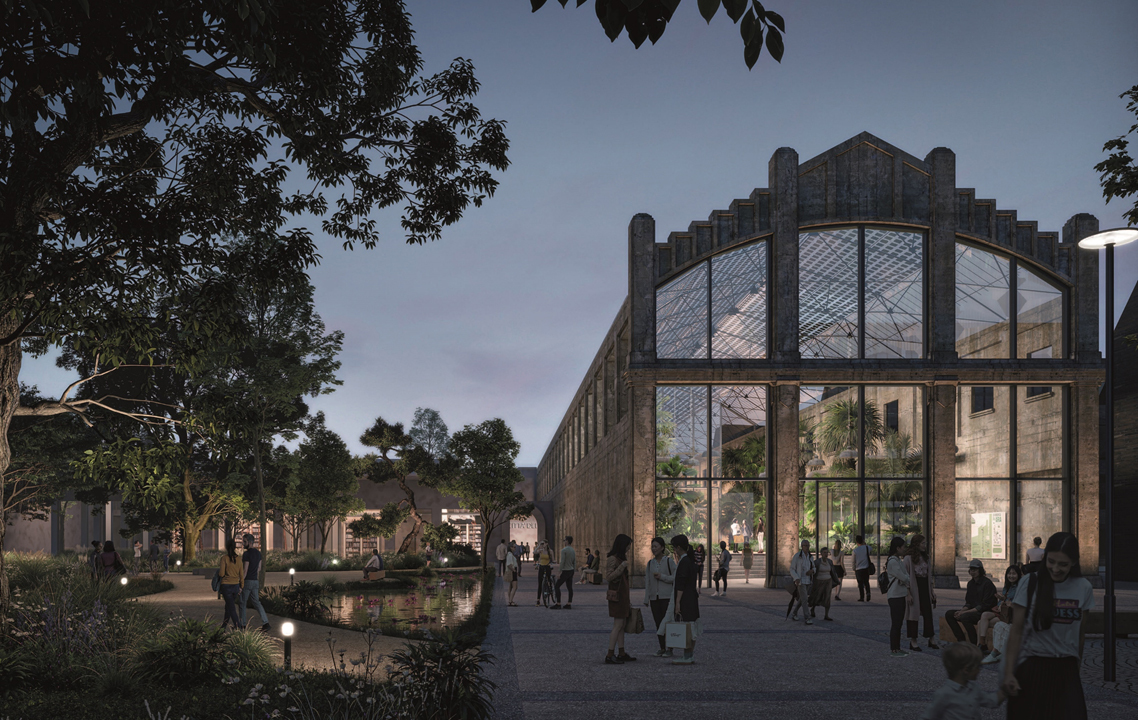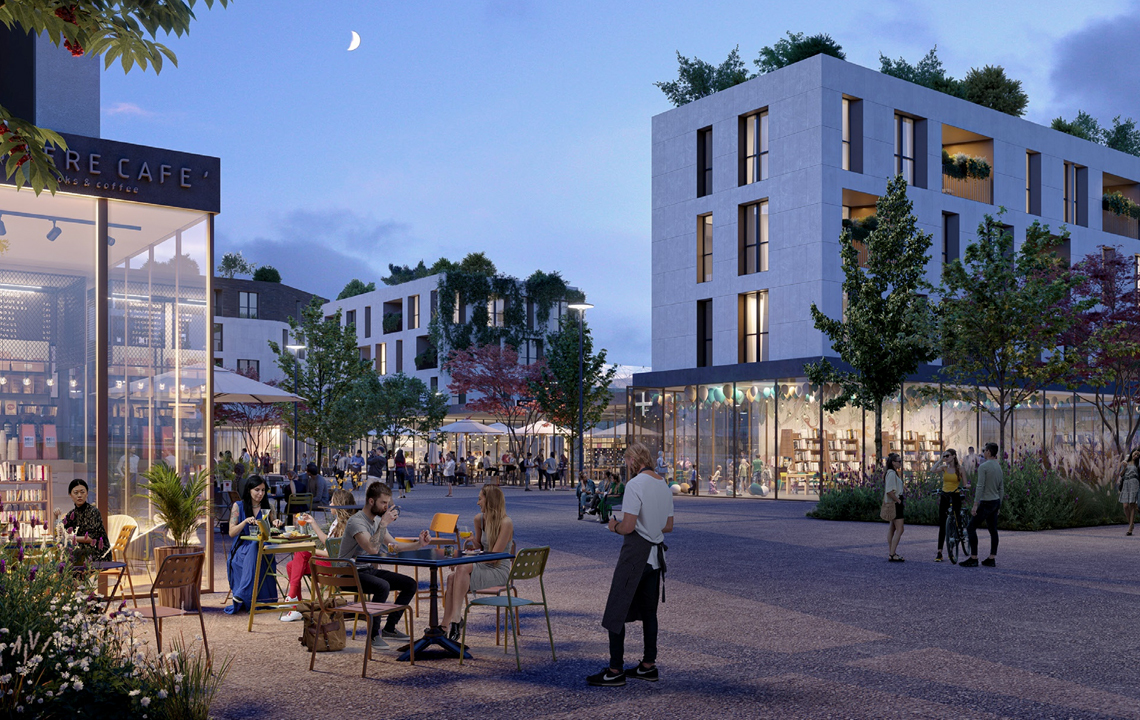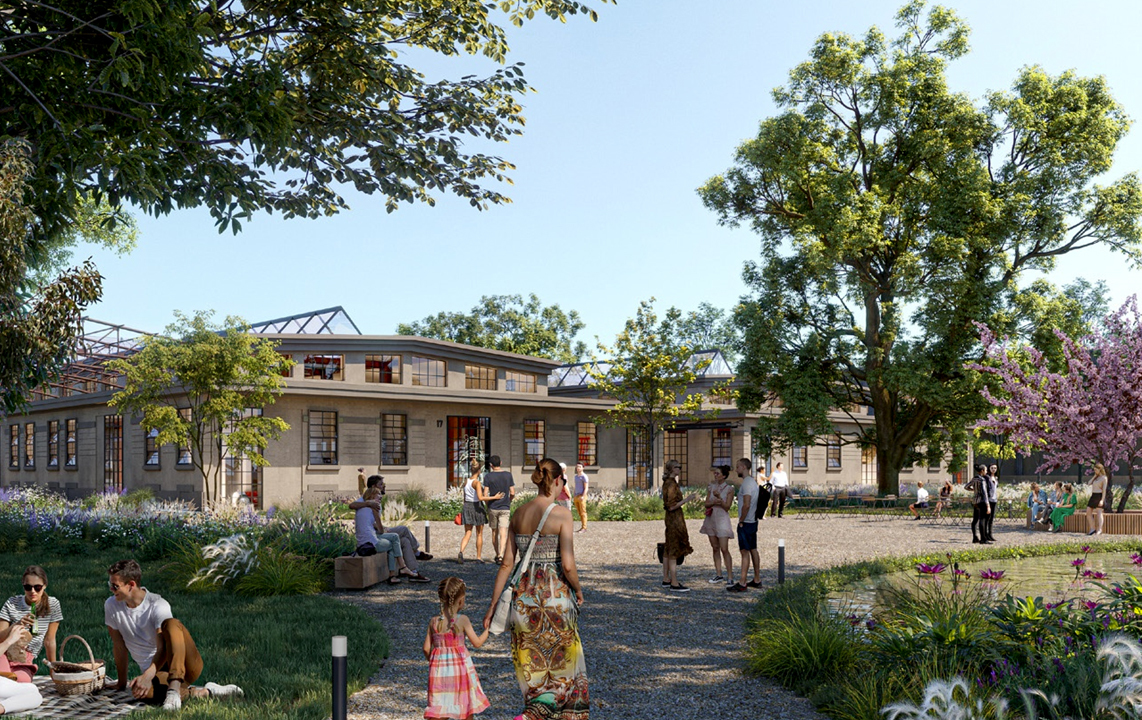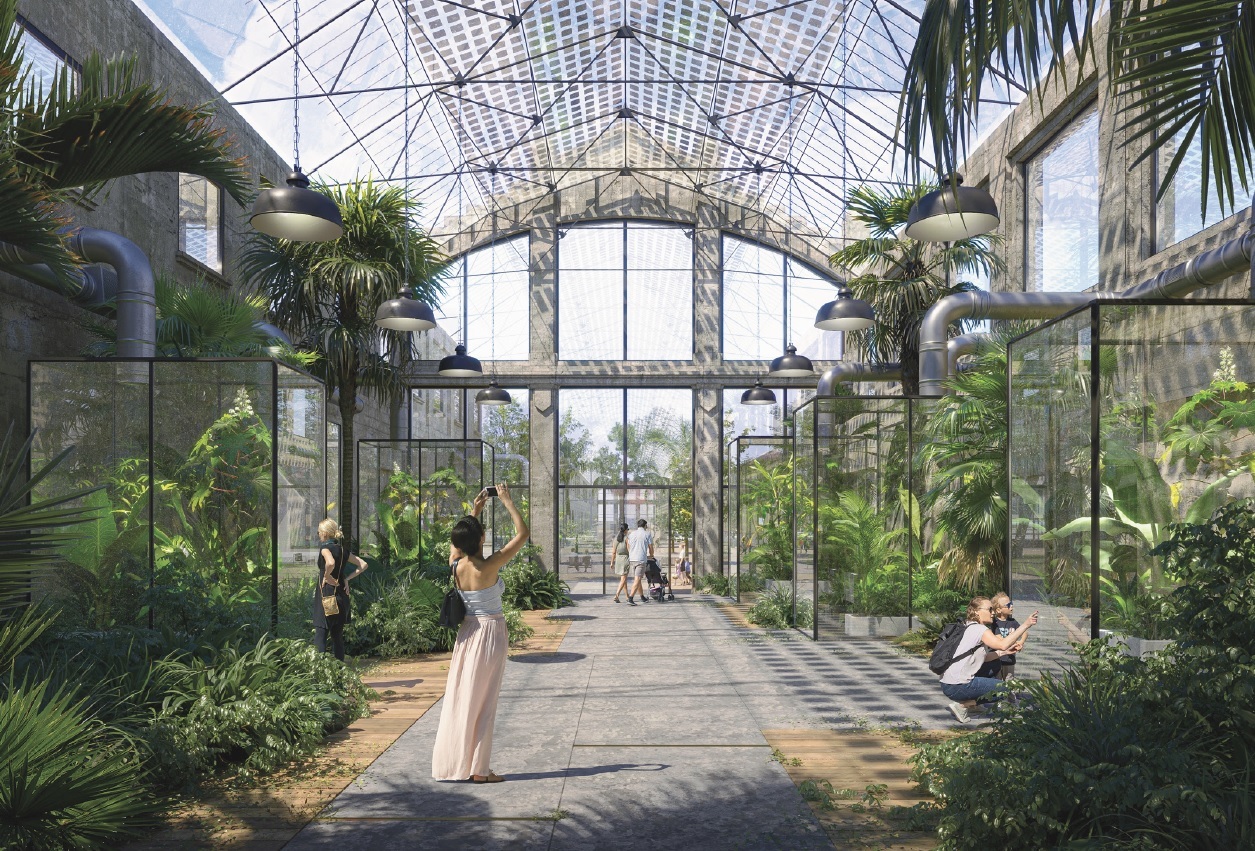
Project Profile: Aria Milan – Designing a science, art and education core for one of Europe’s most important urban regenerations
Chapman Taylor is part of an international design team which won a competition for a major new mixed-use neighbourhood as part of the urban regeneration of Milan’s Ex Macello district. The 16-hectare Aria urban design project will create a new, innovative and attractive area for young workers and students as part of one of the most important social housing projects in Europe.
The collaborative project repurposes a former industrial complex of 6,500m2 in area, including new buildings and retained historic buildings such as old tunnels, hangars, warehouses and factories. The site will be home to the European Institute of Design, with the 30,000m2 campus offering capacity for 4,500 students, plus a student residence for 600 people placed within the retained former slaughterhouse heritage building on the site.
Chapman Taylor Milan Architect Vittorio Caponetto is leading Chapman Taylor's team on this important project. Below, he outlines how Chapman Taylor became involved in the project, the challenges of designing modern uses for heritage buildings and the joy he finds in giving old buildings new roles.
What was the genesis of Chapman Taylor’s involvement in this project?
Part of the origin of the project, from Chapman Taylor’s point of view, was concept work I had produced, just as an interested citizen, exploring ideas about how a place of science and learning, among other elements, could form a core part of a holistic approach to urban regeneration. As part of this concept work, I spoke to various investors and stakeholders in the industry to look at ideas about how such a place might work in practice.
My central idea was that we, as ordinary citizens, are often confused and easily misled by misinformation in relation to very important science-related topics which affect all of us, from nuclear energy to genetically modified crops to the recent COVID-19 pandemic and the vaccines produced in response to it.
My discussions with scientists and others revolved around the concept of helping to rectify this by providing spaces within communities in Milan where people could learn about science, with researchers and teachers at these new institutions themselves proactively involving themselves with the communities within which they would sit.
We developed some ideas and presented them to investors I knew, who expressed great interest and told me about a new masterplan competition they were involved with for one of Europe’s largest social housing projects (a 16-hectare former slaughterhouse site) in an area of Milan called Ex Macello. They believed that our ideas were perfect for the masterplan concept they were creating and asked Chapman Taylor to develop a design concept for three large, abandoned buildings on the site as part of a large team of international partners collaborating on the project.
The masterplan concept won the design competition and we are now developing the phasing strategy for this complex, large-scale urban regeneration.
Tell us about the main elements of Chapman Taylor’s part of the masterplan.
The masterplan competition took place under the banner of “C40 - Reinventing Cities”, which is an initiative to promote the creation of sustainable communities and buildings within abandoned or run-down areas. Socially and environmentally sustainable design is at the core of our concept and of the masterplan as a whole.
Chapman Taylor’s contribution to the masterplan includes the “POD”, meaning “Point of Disclosure”, which will be the new science and art district, entirely dedicated to what are known as the “STEAM” fields (science, technology, engineering, art and mathematics). The site will be home to new functions and services, as well as offices, craft workshops, laboratories, co-working spaces, training and advice amenities for start-ups and retail space. We have collaborated with scientific experts from, among others, The Genoa Science Festival, TheFabLab and Eatour, recognised as one of the top 100 most innovative start-ups in the world in the last two years by the UN agency UNWTO.
Central to the POD development’s dynamism will be the presence of the European Institute of Design (IED). The POD will include a 30,000m2 campus offering capacity for 4,500 students, plus a student residence for 600 people. There will also be 1,200 affordable social houses for families within the development. The result will be a consolidated design hub which will be unique in Italy, perhaps in Europe.
At the moment, the IED is geographically spread across a wide area of Milan, but the POD development will allow them to concentrate all of their courses, from vehicle design to graphics to fashion, as well as their R&D work, under one roof within a beautiful building – a derelict, but architecturally elegant, former slaughterhouse complex. As well as the IED, the buildings will house R&D start-ups and spaces for exhibitions and events.
The POD element will be the heart of the masterplan, providing the dynamic face of the entire development. This vibrant hub will animate the life of the neighbourhood through diverse cultural events and activities. Students and residents will be the new city-makers, helping to ensure Aria’s place as a key new urban destination with a sustainable, circular economy design ethos.
The POD initiative will occupy the central portion of the beautiful long gallery-like building we are repurposing as well as a disused former bridge-like structure which was once used to hang carcasses. Initially, the latter was considered so unwieldy in shape (5m in width x 250m long) that demolition was considered; Chapman Taylor proposed hydroponic gardens, a water garden, a hydroponic café offering food and drink created from plants grown in the upper level hydroponic farm, which will have great views over the new park which will be created. Our ideas for the building delighted the local authority, which had been at a loss about how to repurpose it.
The newest of the existing buildings was also challenging, in terms of how it could be repurposed effectively, because the interior contains many structural pillars. We proposed a bookshop, a hydroponic bistro and kitchen (which can be used for lessons on hydroponic culture and cooking), providing a sustainable and exciting new role for the building.
It is wonderful to work within these beautiful industrial heritage buildings to provide them with a new social purpose; the buildings were designed in the early 20th century with precision and care so that they suited their functions perfectly yet were also resilient and aesthetically pleasing. To give them new life is a privilege for us.
How does the design ensure a truly sustainable development?
The three existing industrial buildings are rightly protected by heritage regulations, but this creates challenges for repurposing them effectively. For example, achieving top sustainability performance is harder in heritage buildings because of the limits imposed on how and where a design can intervene. Despite these challenges, we are targeting LEED Gold accreditation for sustainability, with the masterplan designed to achieve LEED Cities & Communities certification and a high ReSMART Index score for the useability and usefulness to residents of its services, technology and infrastructure.
105% of the POD's annual net energy needs will be provided by renewable energy generated on site, with local energy storage for long-term resilience. Among the performance requirements will be:
- The global primary energy index of the buildings being less than 60 kWh per m2
- Balance between energy production (thermal and electrical) from renewable sources present on site and energy needs (heating, cooling, ventilation, lighting, electrical auxiliaries)
- Minimised management and maintenance costs (functionality and durability requirements).
A unique feature of the sustainable masterplan will be its many “Air Factories”, high-performance glazed units which will serve to purify the air and water in indoor environments, filtering atmospheric contaminants through the use of plants and soil and capturing CO2 for storage. These spaces will be meeting places for community groups and others who live in or near the neighbourhood. We have designed the buildings to include these units without them touching the existing walls. These will line the long gallery building on either side of the POD area.
The restored industrial buildings will have glazed roofs which will allow in abundant light, with automatic shading to filter out harsh sunlight and control solar heat gains, as well as solar panels. Natural ventilation will be a central part of the sustainability strategy for the repurposed structures. A vertical farm will be installed to teach people about how to grow food efficiently without the need for soil, using harvested rainwater purified by UV technology.
Aria will be the first Carbon Negative Area in Milan thanks to a supply of thermal and cooling energy to the entire district as well as high-efficiency power supplied through innovative ectogrid™ technology and the installation of 3,600m2 of photovoltaic cells.
Fitting all of this in within the existing buildings without being able to substantially alter the fabric of the buildings has required careful thought and some ingenuity on our part. However, I very much enjoy this process; I love designing for flexibility and easy dismantling, which is what we are doing here – it helps to future-proof buildings and ensure that they can adapt with ease to new changes in society and technology.
To do this in a way which ensures that the heritage of these buildings is protected for another century is very satisfying for me. We have been very careful in our choice of materials, both from a sustainability point of view and in terms of protecting the heritage elements. It has been particularly rewarding to learn about the traditional techniques which were used for the original buildings, such as for the ornate plastering. We are very often finding something new and interesting as we work in these buildings!
Tell us about the extensive collaboration required on this project.
The Aria masterplan is a collaboration between many companies, consultants, institutions, local authorities and individuals, all with expertise in a wide array of fields[i]. It feels like the coming together of like minds to achieve something special for Milan and for Italy.
We have collaborated extensively in recent months with lead masterplan architects Snøhetta Oslo as well as local architects Barreca & La Varra, Canadian project managers / sustainability pioneers Stantec and CZA Cino Zucchi Architetti (architects for the IED Campus), as well as the lead partner on the project, REDO SGR Società Benefit.
The challenge, on large-scale and complex projects such as these, is to define boundaries and responsibilities without creating a siloed culture; Aria is a particularly diverse project, with a mixture of old and new buildings, a large landscaping element, a variety of functions and amenities and a wide range of stakeholders.
Chapman Taylor has decades of successful experience working on large and complex developments, and the key, for us, is to establish excellent interpersonal relationships and open lines of communication throughout the project. This means that we know how to avoid our responsibilities clashing with those of other members of the Aria team in a way which makes the transition seamless and ensures a coherent overall project.
What are the next steps for the Aria / POD project?
Currently, the preliminary phase of the project has been completed and the next phase is to develop the design to building permission stage. Should we be successful, we will move to the working drawings and construction phases. The client has set an ambitious deadline of 2025 for completion of the project.
Once complete, we envisage a long-term association with the POD initiative, with ongoing collaboration with the IED and others (including new contacts with the Massachusetts Institute of Technology about possible collaboration with the IED to develop new ideas on space travel).
We are very enthusiastic about Chapman Taylor being a part of a new era of civic discussion in Milan about topics such as science, arts, design, sustainability, even extra-planetary colonisation! It is important to us to be civically engaged with the society around us and to hopefully find new ways, through these creative and collaborative interactions, that we can serve progress through design.
[i] The lead partner on this project is REDO SGR Società Benefit, working alongside the IED, CA Ventures, E.ON, Deltaecopolis and CCL. Snøhetta Oslo is Lead Architect, with the architectural team including Barreca & La Varra, Stantec, CZA Cino Zucchi Architetti (for the IED Campus), Chapman Taylor, Mpartner and Fondazione Housing Sociale.
Other partners on the Aria project are: Prof. Mario Motta for Fondazione Politecnico di Milano, Prof. Marco Filippi, Prof. Stefano Mancuso for PNAT, Deloitte, MIC Mobility-in-Chain, Planet Smart City, GaiaGo, LifeGate, Cresme Ricerche, LAMA Società Cooperativa – Impresa Sociale, Fondazione Don Gino Rigoldi, Edoardo Tresoldi, ènostra, Amici di Edoardo, The FabLab, Festival della Scienza, Eatour, Electreon, Mare Culturale Urbano abd Giacimenti Urbani.
Working alongside Vittorio in the Chapman Taylor team in developing ideas and designs for this innovative project are Susanna Oddi, Valdo Canepa, Cristina Cattaneo, Giuditta Rizzato, Abdeljahil Atar, Zihao Zan and Christelle Ayoub.
* GGIs courtesy of Wolf Visualizing Architecture.


